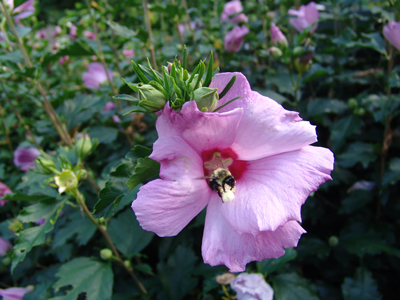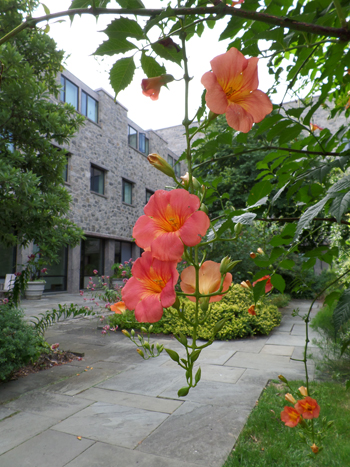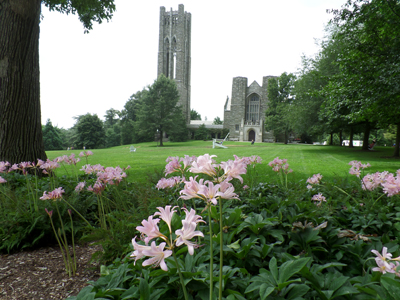Plants of the Week: August 5
 While purple coneflower may be a more popular Echinacea, new colors have been cultivated recently such as this yellow coneflower: Echinacea ‘Leilani.’ This elegant plant is fittingly named ‘Leilani’ because it means “royal child of heaven.” Use this plant to add a splash of sunshine to any garden, especially for mass plantings in perennial borders. Echinacea ‘Leilani’ features bright yellow, daisy-like flowers with downward radiating petals from a distinct, cone-shaped, central seed head. Yellow coneflower blooms from mid to late summer for over a month and may re-bloom if dead-headed. If spent flowers are not removed, a greenish bronze central cone remains to provide winter interest, seeds for goldfinches, and a focal point for dried floral arrangements. Just like all other Echinacea, this cultivar is drought, heat, and deer tolerant.
While purple coneflower may be a more popular Echinacea, new colors have been cultivated recently such as this yellow coneflower: Echinacea ‘Leilani.’ This elegant plant is fittingly named ‘Leilani’ because it means “royal child of heaven.” Use this plant to add a splash of sunshine to any garden, especially for mass plantings in perennial borders. Echinacea ‘Leilani’ features bright yellow, daisy-like flowers with downward radiating petals from a distinct, cone-shaped, central seed head. Yellow coneflower blooms from mid to late summer for over a month and may re-bloom if dead-headed. If spent flowers are not removed, a greenish bronze central cone remains to provide winter interest, seeds for goldfinches, and a focal point for dried floral arrangements. Just like all other Echinacea, this cultivar is drought, heat, and deer tolerant.
Photo Credit: Aaron D’Addio
Garden Location: Biostream
 Hibiscus syriacus ‘Minerva’ is a deciduous summer flowering shrub known for its extended blooming season, showy flowers, minimal seed production, and bountiful continuous flowering. Also known as rose of Sharon, this plant displays showy, lavender flower petals with ruffled margins. These blooms have dark red eyes with the distinguished hibiscus staminal column protruding out from the center. Each individual flower blooms for a single day; however, it develops seemingly endless new flower buds for continuous blooming from early summer to autumn.
Hibiscus syriacus ‘Minerva’ is a deciduous summer flowering shrub known for its extended blooming season, showy flowers, minimal seed production, and bountiful continuous flowering. Also known as rose of Sharon, this plant displays showy, lavender flower petals with ruffled margins. These blooms have dark red eyes with the distinguished hibiscus staminal column protruding out from the center. Each individual flower blooms for a single day; however, it develops seemingly endless new flower buds for continuous blooming from early summer to autumn.
Photo Credit: Aaron D’Addio
Garden Location: Between Old Tarble & Worth Health Center
 Campsis grandiflora ‘Morning Calm’ is a deciduous woody vine which can climb to thirty feet high. Commonly known as Chinese trumpetcreeper, it is not as aggressive as our native American trumpetcreeper. This cultivar features open clusters of hanging, trumpet-shaped, peach-apricot flowers with yellow throats. Campsis grandiflora ‘Morning Calm’ blooms in early summer and continuously flowers into autumn, and is a hummingbird magnet.
Campsis grandiflora ‘Morning Calm’ is a deciduous woody vine which can climb to thirty feet high. Commonly known as Chinese trumpetcreeper, it is not as aggressive as our native American trumpetcreeper. This cultivar features open clusters of hanging, trumpet-shaped, peach-apricot flowers with yellow throats. Campsis grandiflora ‘Morning Calm’ blooms in early summer and continuously flowers into autumn, and is a hummingbird magnet.
Photo Credit: Aaron D’Addio
Garden Location: Isabelle Cosby Courtyard
 Do you like surprises? If so, then you will love Lycoris squamigera. This plant has many fun nicknames including: surprise lily, resurrection lily, magic lily, and naked lady. Don’t be disappointed when its leaves emerge in spring and then soon die and wither away in the summer. Just when you think that this plant is dead, in late summer it surprises you by being “resurrected” like magic with a naked flower stalk that quickly emerges from the ground. These leafless, sturdy stalks support a cluster of numerous, fragrant, pink streaked with lavender, trumpet-shaped flowers that create a jaw-dropping magic show. Resurrection lily is not truly a lily, as it is in the Amaryllis family. Lycoris squamigera pairs perfectly with hostas or hellebores which provide foliage to create a pleasant background for its flower clusters, unless you enjoy its unique “naked lady” appearance.
Do you like surprises? If so, then you will love Lycoris squamigera. This plant has many fun nicknames including: surprise lily, resurrection lily, magic lily, and naked lady. Don’t be disappointed when its leaves emerge in spring and then soon die and wither away in the summer. Just when you think that this plant is dead, in late summer it surprises you by being “resurrected” like magic with a naked flower stalk that quickly emerges from the ground. These leafless, sturdy stalks support a cluster of numerous, fragrant, pink streaked with lavender, trumpet-shaped flowers that create a jaw-dropping magic show. Resurrection lily is not truly a lily, as it is in the Amaryllis family. Lycoris squamigera pairs perfectly with hostas or hellebores which provide foliage to create a pleasant background for its flower clusters, unless you enjoy its unique “naked lady” appearance.
Photo Credit: Aaron D’Addio
Garden Location: Magill Walk





Lynn
Posted at 23:04h, 09 AugustGreat post! 🙂
Aaron D'Addio
Posted at 07:43h, 12 AugustThank you!
Richard Bartolone
Posted at 08:41h, 12 AugustAaron,
Very professional work! Delighted you are doing so well.
Wishing you all the best to a bright horticultural career,
Rich
Aaron D'Addio
Posted at 15:59h, 12 AugustThank you Rich! I owe it to you teaching me so well and for the endless letters of recommendation as well.